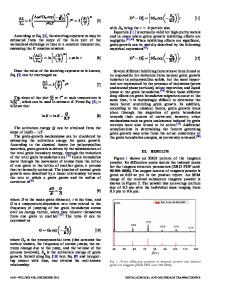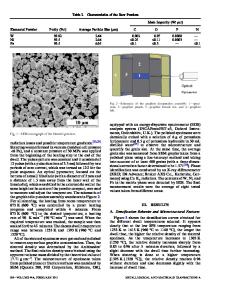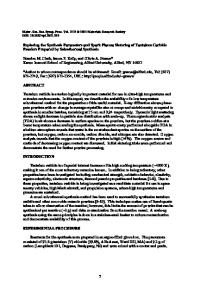Full Densification of Molybdenum Powders Using Spark Plasma Sintering
- PDF / 677,468 Bytes
- 8 Pages / 593.972 x 792 pts Page_size
- 17 Downloads / 394 Views
NTRODUCTION
MOLYBDENUM has a body-centered-cubic structure with a melting point of 2883.15 K (2610 °C) and a density of 10.22 g/cm3 and presents a great potential to become an important refractory metal. The refractory properties of molybdenum reflect the high strength of its interatomic bonding.[1] This material was used for hightemperature applications in a variety of industries. In addition, the relatively low thermal neutron cross section of Mo makes it suitable for nuclear applications. The unique combination of physical, chemical, and mechanical properties of Mo makes it an ideal material for a variety of engineering applications where hightemperature resistance and ductility are key issues.[1–5] Molybdenum was used in many electronic applications from the earlier days of the technology. This metal combines both satisfying thermal conductivity (142 W/ mÆ K at 293.15 K (20 °C)) and a coefficient of thermal expansion, which offers a good match with that of silicon (4.8 and 2.6 ppm/K at 298.15 K (25 °C), respectively). Thanks to that large area, silicon devices (up to B. MOUAWAD, Postdoctoral Student, formerly with the Universite` de Lyon, INSA de Lyon, AMPERE-UMR 5005, 69621 Villeurbanne Cedex, France, and is now with the Universite` de Toulouse, 31062 Toulouse, France. M. SOUEIDAN, Research Fellow, is with the Universite` de Lyon, INSA de Lyon, and also with the Lebanese Atomic Energy Commission, Riad El Solh 1107 2260 Beirut, Lebanon. Contact e-mail: [email protected] D. FABRE`GUE, Associate Professor, is with the Universite` de Lyon, INSA de Lyon, MATEIS-UMR 5510, F-69621 Villeurbanne Cedex, France. C. BUTTAY, Research Fellow, B. ALLARD, Professor, and H. MOREL, Senior Scientist, are with the Universite` de Lyon, INSA de Lyon, AMPERE-UMR 5005. V. BLEY, Lecturer, is with the Universite` de Toulouse. Manuscript submitted April 11, 2011. Article published online May 23, 2012 3402—VOLUME 43A, SEPTEMBER 2012
10 cm in diameter) can be directly bonded onto a molybdenum disk to improve their mechanical strength in high power, press-pack packages.[6] Such components were manufactured for several decades, using molybdenum disks directly stamped from fully dense wrought sheet. In this way, the deleterious effects of residual porosity on the thermal conductivity are eliminated. Generally, powder metallurgy was used for the production of bulk Mo components.[3–5] High sintering temperatures, in the range of 2073.15 K to 2273.15 K (1800 °C to 2000 °C), with long sintering times, are required for densification above 90 pct of the theoretical density for refractory metals. Because of the difficulty in achieving full densification of Mo, much research focused on the enhancement of sinterability. In this regard, one of the suggested processes for enhancing sinterability is the activated sintering process in which a metal such as Ni, Pt, Pd, or Co is added to Mo.[7–13] However, these elements can degrade the electrical and thermal properties of the Mo. To achieve nearly full density in short processing time intervals, while co
Data Loading...











